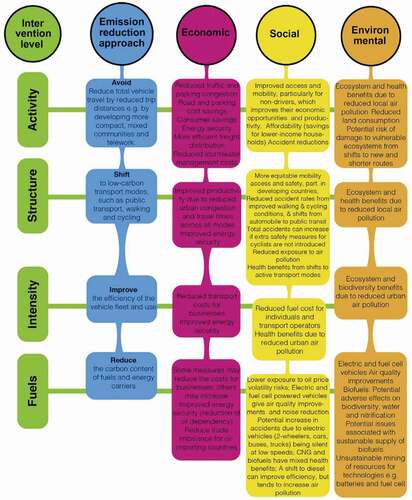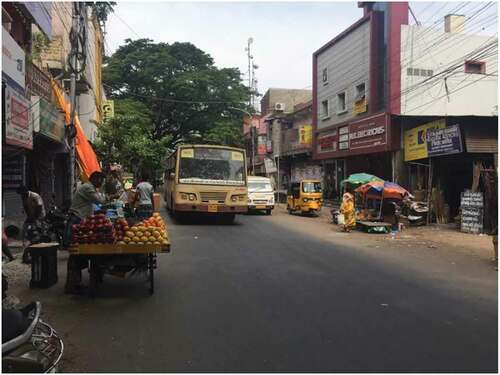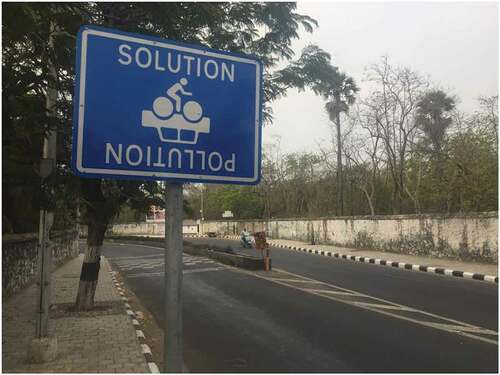ABSTRACT
The COVID-19 pandemic has recently forced half of humanity to experience an unprecedentedly expansive lockdown. Naturally, this has brought urban transport systems under a near standstill, which in turn resulted in a sharp drop in carbon emissions and levels of air pollution in affected areas. While the induced health and economic crisis is already lasting longer and affecting many more than originally expected, questions arise on what that means for the future of urban living, urban design and connectivity. A post-COVID-19 city could notably see a sustained drop in demand for commuting transport due to a combination of enduring economic crisis and changing work habits. It could experience a behavioural shift with regard to crowded spaces, and public transport in particular. In such context, this snapshot piece aims first at examining the possible consequences on public health of this scenario. Secondly, it uses system thinking to evaluate how stimulus plans could maximise social, health and climate co-benefits. It takes the example of populous middle-income countries to suggest a shift to investing in infrastructure focused on active travel modes, as the most prone to cheaply sustain hygiene, social-equity, reduced exposure to air pollution, reduced numbers of fatal accidents, and enhanced levels of physical activity.
© 2020 The Author(s). Published by Informa UK Limited, trading as Taylor & Francis Group
The COVID-19 pandemic constitutes an unprecedented, multi-faceted worldwide experiment for movement in cities. Initial optimism over the virus’ grasp and swift return to usual activities has now switched to a widely shared understanding that the public health crisis is global and requires immense recovery efforts. Public health experts suggest that with insufficient time to reach herd immunity or find and produce stocks of vaccines, social distancing will be necessary for a period of up to 18 months. This is already leading to an alteration of possibilities in social life, causing a global economic shock rivalling the Great Depression and other indirect societal destabilisations of all kinds. Transport policymakers, in particular, are left unprepared as models did not anticipate a world of social distancing primacy.
Urban transport systems were brought to a standstill during the particular period of lockdowns and/or other social restriction measures. Movement constrictions have been concomitant with record temporary reductions in noise, road accidents and air pollution (Mahato et al. Citation2020, Tobias et al. Citation2020). Lower exposure to air pollutants in particular impacts major risk factors of the most common non-communicable diseases such as lung cancer, respiratory infections, stroke, ischaemic heart disease, chronic obstructive pulmonary disease and depression. However, the near disappearance of commuting also leads to reduced physical activity which is associated with higher body-mass index, type-2 diabetes, coronary heart disease, certain cancers and depression. All in all, the occurrence of cardiovascular and pulmonary illnesses, major causes of morbidity and mortality around the world, will vary, although comprehensive impact studies over long-term effects are still lacking.
In parallel, the urgency to decarbonise the transport sector remains even considering a sharp drop of greenhouse gas emissions in 2020, as the US National Oceanic and Atmospheric Administration reported on May 2nd that the Earth had reached 417 parts per million of CO2 in the atmosphere at the Mauna Loa in Hawaii. To put the COVID-19 toll in context, the World Health Organization estimates that climate-related causes will inflict 250,000 deaths/year between 2030 and 2050 (World Health Organization Citation2018).
The transport sector sits at the unique interaction of mobility, connectivity, land use, economic development, public health and the climate crisis. Now, the zoonosis mandates to add social distancing for the foreseeable future to these parameters of what a transport system should tackle. Instead of trying to tackle these issues one by one, the system approach enables to combine multiple objectives from the policy design phase onward. maps how these objectives can be achieved through transport interventions (from Lah and Lah Citation2019). This approach consists of identifying ex ante the trickle-down potential of interventions and assessing which policy set maximises social, health, climate and cost co-benefits, effectively increasing its resilience. For example, the estimated impact of low carbon scenarios in European cities on physical activity levels, accidents, noise, air quality, congestion and fuel savings can be key to decide whether to invest in corresponding infrastructure (Creutzig et al. Citation2012). The system approach further brings the additional benefit of showing that part of the economic and health co-benefits can be achieved over a short time period and within the community undertaking the given effort, thus increasing societal and political justification for implementation.
Figure 1. Induced effects of climate mitigation policies in transportation (from Lah and Lah Citation2019)

Reduced health impacts of air pollution have already proven huge in China and Europe during the lockdowns (Myllyvirta and Thieriot Citation2020). Questions thus abound over what lies ahead for commuting demand and whether cities will be able to retain the reduced levels of negative externalities from transport. A typical post-COVID-19 city could see a sustained drop in commuting due to a combination of enduring economic crisis and changing work habits, which would also lower down the cost of reducing emissions and even obliterate the rush hour. An important lesson from the pandemic is that behavioural shifts can happen at a very large scale. Communities adapted to the confinement rules at a pace trumping what behavioural science suggested. Another key fact is that the shakedown happened almost everywhere, so there are potential similarities in how to respond.
The risk is that when lockdowns are lifted, mode choice might be altered to the detriment of shared vehicles and public transport out of fear of contamination in crowded environments. More people may opt for personal private modes of transport in order to protect themselves from catching the virus. The cases of Beijing and Wuhan offer a cautionary tale, as car traffic quickly ramped up to pre-COVID-19 levels, although only at peak times, while public transport and long-distance rail have persistently trailed. A global shift to cars could lead to a catastrophic cocktail involving more energy and costs expenditure, traffic and transport-related physical inactivity, even assuming a substantial shift to electric drivetrains. The preference for cars could be made durable through a heightened desire from urban populations to relocate to the countryside in order to enjoy more space and gardens. This push for urban sprawl renews the need to regulate mobility, connectivity, geographic implementation of offices and land use altogether if planners want to ensure that commuting distances stay within reach of active modes users.
Alternatively, walking and cycling could take over thanks to the general disturbance in daily habits and temporary dedicated infrastructure being implemented by policymakers wary of commuters’ health and safety. Active modes are adaptable and socially inclusive. They require a low per-person budget and ensure that more money is spent within the community rather than in fuel. Active modes are encouraged by the World Health Organization and cities such as Chennai, India as seen in , as they maximise the health benefits from transport through increased physical activity, reduced exposure to air pollution, noise and lower occurrence of fatal accidents (Hérick de Sa et al, Citation2017). Enhanced air quality from transport policies could even reduce mortality for lung-related transmittable diseases, such as COVID-19 (Wu et al. Citation2020). Walking and cycling can further be associated with smart, electrically assisted micromobility modes in order to raise inclusiveness, widen the geographic range beyond the 10–12 km generally seen as maximum cycling distance for commuting, and help with difficult topographies. Modes that already enjoy cost-effective technology deployment include electric bikes, electric scooters and shared bikes which proved useful in Wuhan for emergency services.
This strategy varies substantially from the sustainability scenarios focusing primarily on the bolstering of public transport networks but nonetheless holds major health benefits. This fact is especially important in low- and middle-income countries which have been experiencing a relative growth of NDCs in the overall health burden. These cash-constrained countries also have to prioritise other development goals, such as water sanitation. With limited road space, low-tech and low-cost options such as walking and cycling are sound land use solutions as they ensure social distancing at scale while maintaining connectivity and limiting the need for complex governance and street redesign. Dedicated active modes infrastructure can remarkably be reproduced anywhere with nuances, given the low associated cost and footprint. It can provide a new safe mobility option to the captive commuters impacted by the looming economic crisis and reduced public transport service.
Hindering factors of a shift to walking and cycling include negative social views towards such modes, historic gender imbalance in cycling habit, extreme weather events, low integration of transport grid, lack of understanding of local needs and low road safety and security. Furthermore, insufficient institutional dialogue between public health officials, urban planners and transport policymakers at city and national levels can weaken the ability to attract new sources of funding if cobenefits are not demonstrated to be attained locally and in a short period of time. Schemes encouraging active travel can also encounter resistance from car users, who belong to a higher income group and are often seen as the most important tax contributors. As a consequence, the transport policy and research worlds have historically been skewed towards long-distance, motorized modes, even though shifting budget to active modes instead would serve many more commuters and transform more roads thanks to lower price tag.
A range of measures necessary to prevent traffic bottlenecks and allow such switch start by a quick transformation of the space freed by absent cars into pathways and cycle lanes. Temporary spatial arrangements of roads could lead to permanent change if usage rates are sufficient and lead to visible short-term benefits. Major road infrastructure projects put in doubt by the economic crisis and lower demand forecasts could be refocused towards cycle superhighways. Pricing mechanisms can also help divert people from certain modes and shave peak traffic, which would also productivity losses due to congestion and alleviate overloaded networks. Road pricing and direct subsidies to active modes users are fair considering that not using private motorised modes generates multiple positive externalities while the stimulus plans will certainly flow towards carmakers, hopefully to bolster fleet electrification and availability of charging sites.
Higher shares of walking and cycling will be of particularly beneficial effect in populous low- and middle-income countries because they will alleviate pressure on often-overloaded public transport systems. However, maintaining quality of public transport will remain essential, not least because they extend transport possibilities for persons with reduced mobility. They provide a buffer system in case of extreme weather such as floods and heatwaves. They create quality jobs. Public transport is used a lot by essential workers, a fact that was revealed by the crisis. Challenging configurations will have to be found to enable social distancing while bridging the financial gap between reduced passenger flows and maintained supply, possibly through more subsidies (Welle and Avelleda Citation2020). illustrates some of the challenges that public transport in a city like Chennai, India were already facing before COVID-19, including competition for road space and bus fleets in urgent need of replacement. The momentaneous reduced pressure on transport networks makes the implementation of such solutions, but also bus corridors and electrical buses easier.
Figure 3. Photo of a street in Chennai. The city aims to electrify part of its bus fleet to reduce noise and air pollution

The COVID-19 pandemic offers an unlikely opportunity to advance a range of UN sustainable development goals related to the transport sector: SDG 1 on ending poverty, SDG 3 on ensuring healthy lives and wellbeing, SDG 9 on infrastructure, SDG 10 on reduced inequalities and SDG 11 on making cities inclusive, safe, resilient and sustainable. Meanwhile, cities around the world are currently expressing a high interest for green recovery to enhance wellbeing. Active modes offer the most value for investment and their diversity ensures they can meet some needs that public transport cannot provide anymore due to social distancing. Still, more quantified case studies are needed to inform politicians seeking to climate-proof the recovery while bringing long-term value to the vast economic stimuli currently being discussed. Case studies should explore more potential cobenefits and circumstances, such as long-range commuting in rural areas, allowing for data comparison. Researching behavioural effects of temporary infrastructure projects will be of particular importance, taking into account social inclusion and gender equality. Ultimately, the transition will rely on political choices at all levels of governance.
Disclosure statement
No potential conflict of interest was reported by the author.
Additional information
Notes on contributors
Arnaud Koehl
Arnaud Koehl is a Ph.D. researcher based at Imperial College London. He works at the Health Policy Evaluation Unit, School of Public Health, and at the Grantham Institute. He joined Imperial after completing his MSc in Economics and Policy of Energy and the Environment at University College London. Arnaud holds an MA in International Relations and a Diploma in Latin American Studies from the Lyon Institute of Political Studies. Arnaud is also a research assistant for the Grantham Institute at the London School of Economics, working on Climate Change Laws of the World.
References
- Creutzig, F., et al., 2012. Decarbonizing urban transport in European cities: four cases show possibly high co-benefits. Environmental research letters, 7, 044042. Available from: https://iopscience.iop.org/article/10.1088/1748-9326/7/4/044042/meta
- Hérick de Sa, T., et al., 2017. Health impact modelling of different travel patterns on physical activity, air pollution and road injuries for São Paulo, Brazil. Environment international, 108, 22–31. doi:10.1016/j.envint.2017.07.009
- Lah, O. and Lah, B., 2019. Opportunities for synergies and cobenefits. In: Sustainable urban mobility pathways, Chap. 4, 81–98. Available from: https://www.sciencedirect.com/science/article/pii/B9780128148976000041
- Mahato, S., et al., 2020. Effect of lockdown amid COVID-19 pandemic on air quality of the megacity Delhi, India. Science of the total environment, 730, 139086. doi:10.1016/j.scitotenv.2020.139086
- Myllyvirta, L. and Thieriot, H., 2020. 11,000 air pollution-related deaths avoided in Europe as coal, oil consumption plummet. Centre for Research on Energy and Clean Air. Available from: https://energyandcleanair.org/wp/wp-content/uploads/2020/04/CREA-Europe-COVID-impacts.pdf
- Tobias, A., et al., 2020. Changes in air quality during the lockdown in Barcelona (Spain) one month into the SARS-CoV-2 epidemic. Science of the total environment, 726, 138540. doi:10.1016/j.scitotenv.2020.138540
- Welle, B. and Avelleda, S. 2020. Safer, more sustainable transport in a post-COVID-19 world. World Resources Institute. Blogpost Available from: https://www.wri.org/blog/2020/04/coronavirus-public-transport-stimulus-packages
- World Health Organization, 2018. Climate change and health. Webpage Available from: https://www.who.int/news-room/fact-sheets/detail/climate-change-and-health
- Wu, X. et al., 2020. A national study on long-term exposure to air pollution and COVID-19 mortality in the United States. Harvard University. Available from: https://projects.iq.harvard.edu/covid-pm

